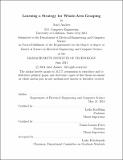| dc.contributor.advisor | Leslie Kaelbling and Tomás Lozano-Pérez. | en_US |
| dc.contributor.author | Anders, Ariel (Ariel Sharone) | en_US |
| dc.contributor.other | Massachusetts Institute of Technology. Department of Electrical Engineering and Computer Science. | en_US |
| dc.date.accessioned | 2014-10-21T16:20:25Z | |
| dc.date.available | 2014-10-21T16:20:25Z | |
| dc.date.copyright | 2014 | en_US |
| dc.date.issued | 2014 | en_US |
| dc.identifier.uri | http://hdl.handle.net/1721.1/91034 | |
| dc.description | Thesis: S.M., Massachusetts Institute of Technology, Department of Electrical Engineering and Computer Science, 2014. | en_US |
| dc.description | This electronic version was submitted by the student author. The certified thesis is available in the Institute Archives and Special Collections. | en_US |
| dc.description | 23 | en_US |
| dc.description | Cataloged from student-submitted PDF version of thesis. | en_US |
| dc.description | Includes bibliographical references (pages 69-71). | en_US |
| dc.description.abstract | Traditionally, robot grasping has been approached in two separate phases: first, finding contact positions that yield optimal grasps and, then, moving the robot hand to these positions. This approach works well when the object's location is known exactly and the robot's control is perfect. However, in the presence of uncertainty, this approach often leads to failure, usually because the robot's gripper contacts the object and causes the object to move away from the grasp. To obtain reliable grasping in the presence of uncertainty, the robot needs to anticipate the possible motions of the object during grasping. Our approach is to compute a policy that specifies the robot's motions over a range of joint states of the object and gripper, taking into account the expected motion of the object when pushed by the gripper. We use methods from continuous-state reinforcement-learning to solve for these policies. We test our approach on the problem of whole-arm grasping for a PR2, where one or both arms, as well as the torso can all serve to create contacts. | en_US |
| dc.description.statementofresponsibility | by Ariel Anders. | en_US |
| dc.format.extent | 71 pages | en_US |
| dc.language.iso | eng | en_US |
| dc.publisher | Massachusetts Institute of Technology | en_US |
| dc.rights | M.I.T. theses are protected by copyright. They may be viewed from this source for any purpose, but reproduction or distribution in any format is prohibited without written permission. See provided URL for inquiries about permission. | en_US |
| dc.rights.uri | http://dspace.mit.edu/handle/1721.1/7582 | en_US |
| dc.subject | Electrical Engineering and Computer Science. | en_US |
| dc.title | Learning a strategy for whole-arm grasping | en_US |
| dc.type | Thesis | en_US |
| dc.description.degree | S.M. | en_US |
| dc.contributor.department | Massachusetts Institute of Technology. Department of Electrical Engineering and Computer Science | |
| dc.identifier.oclc | 892740209 | en_US |
